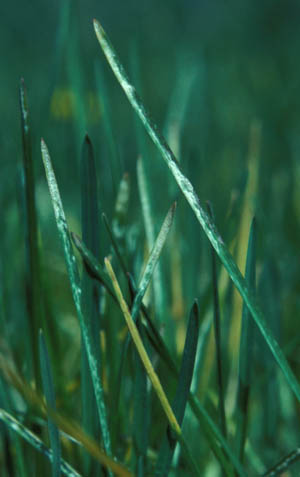Powdery Mildew on Turfgrass | |
|---|---|
| May 2, 2006 | |
Powdery mildew of turfgrass is a cool-season disease and has appeared this season. We see it in Illinois in the spring and again in the fall. It is caused by a fungus, Erysiphe graminis, and is most common on Kentucky bluegrass, bermudagrass, redtop, fine-leaved fescues, and zoysiagrass. Image 060303 shows the powdery white growth of this fungus on some blades of turfgrass.  Affected plants appear to have been dusted with flour. Look for the disease in shady areas of turf where air circulation is minimal. The fungus thrives during cool (55º to 70ºF), humid, cloudy weather (now). The disease can spread rapidly. Under ideal conditions (for the fungus), the conidia (spores) may even germinate and produce infection within 2 hours of landing on a leaf. Although we don’t usually see powdery mildew as a major problem on turf, a severe attack may weaken and kill plants, especially in crowded, newly planted areas. Infected plants are more susceptible to drought, other diseases, and winterkill. The disease is most common in spring, late summer, and fall in Illinois. Mild, cloudy days followed by cool, damp nights favor development of powdery mildew on turf. There is resistance reported to powdery mildew in bermudagrass, some cultivars of Kentucky bluegrass, and several fescue species. Look for resistance information from your seed supplier and use shade-tolerant cultivars in shady sites. It helps to overseed thinned areas of turf with a resistant cultivar or a shade-adapted grass species. Some information on turfgrass cultivars can be found on the University of Illinois Extension turf Web site http://www.turf.uiuc.edu/. It helps to have a strong stand of turf, but apply fertilizer based on soil tests. Excessive nitrogen fertilization actually increases powdery mildew problems. Cultural practices to increase the penetration of light, movement of air, and drying of turf also help. This may mean pruning surrounding plants, spacing new plants, and watering early in the day. It also helps to mow frequently and keep the turf at the recommended height. For bluegrass, this is 1 to 2 inches. More information about this disease can be found in Report on Plant Disease, no. 406, available on the Extension VISTA Web site http://www.ag.uiuc.edu/%7Evista/horticul.htm. |